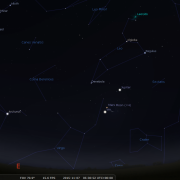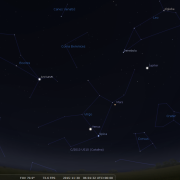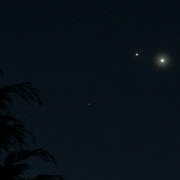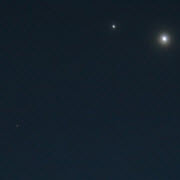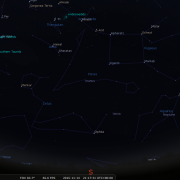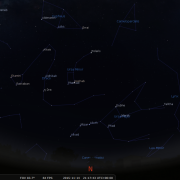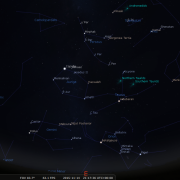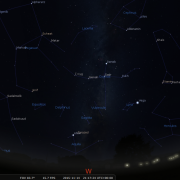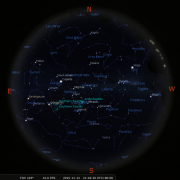In this month's Sky Notes:
Planetary Skylights


 November commences where October left off, with all of the planetary action occurring in the dawn Eastern sky. Look for the close encounter of Mars and Venus, nestling up alongside each other from the 1st to the 4th. Venus is by far the brightest object in the dawn sky and exhibits a half phase when viewed through a telescope. Mars will appear as a fairly conspicuous ‘orange star’, and although will exhibit a tiny disk when viewed through a telescope, little detail will be visible as yet. The waning crescent Moon joins them on the 7th forming a triangle with Mars and Venus. As the month progresses watch as Venus gradually drops back toward the east horizon.
November commences where October left off, with all of the planetary action occurring in the dawn Eastern sky. Look for the close encounter of Mars and Venus, nestling up alongside each other from the 1st to the 4th. Venus is by far the brightest object in the dawn sky and exhibits a half phase when viewed through a telescope. Mars will appear as a fairly conspicuous ‘orange star’, and although will exhibit a tiny disk when viewed through a telescope, little detail will be visible as yet. The waning crescent Moon joins them on the 7th forming a triangle with Mars and Venus. As the month progresses watch as Venus gradually drops back toward the east horizon.
 Rising in the wee small hours, conspicuous Jupiter resides upper left of Mars and Venus. At the end of last month Jupiter was involved in a spectacular conjunction with Mars and Venus, but already clear blue sky exists between them. Jupiter is a fine telescopic object and unlike Venus has plenty of detail on show. Look for the bands and belts across the disk, the great red spot, which appears quite pale and the attendant Galilean moons next to Jupiter. The Moon lies nearby Jupiter on the 6th By the month’s end Jupiter is rising shortly after midnight.
Rising in the wee small hours, conspicuous Jupiter resides upper left of Mars and Venus. At the end of last month Jupiter was involved in a spectacular conjunction with Mars and Venus, but already clear blue sky exists between them. Jupiter is a fine telescopic object and unlike Venus has plenty of detail on show. Look for the bands and belts across the disk, the great red spot, which appears quite pale and the attendant Galilean moons next to Jupiter. The Moon lies nearby Jupiter on the 6th By the month’s end Jupiter is rising shortly after midnight.

 With Saturn having departed the evening sky, Uranus and Neptune are the only realistic 'evening planets' visible to optical aid. At magnitude 6, binoculars will show Uranus, however only a telescope will reveal its tiny disk. It resides around 1 degree below epsilon Pisces. At almost mag 8 Neptune resides in Aquarius between the two naked eye stars of sigma and lambda Aquarii.
With Saturn having departed the evening sky, Uranus and Neptune are the only realistic 'evening planets' visible to optical aid. At magnitude 6, binoculars will show Uranus, however only a telescope will reveal its tiny disk. It resides around 1 degree below epsilon Pisces. At almost mag 8 Neptune resides in Aquarius between the two naked eye stars of sigma and lambda Aquarii.
Meteor Activity

The Leonids are active from Nov 15-20, peaking this year in the early morning hours of Nov 18th. ZHR’s are expected to be normal, ie around 20 per hour, so an observer may expect to view around 7-12. The Leonids are of course famous for their 33yr (or so) periodic outbursts. This coincides with the orbital period of the showers parent comet - Tempel Tuttle. The next major outburst is not expected until around 2031 at the earliest.
Keep an eye out for a few meteors on the night of Nov 4/5th when the South Taurid meteor shower reaches a peak, and then again on the night of Nov 11/12 when the North Taurid meteor shower peaks. This is a very long duration shower with a low rate of around 5 meteors per hour. The peak does not increase a great deal from this, however both the Taurid showers span over a month so there is a good chance you will spot one or two.
Taurids may well be few, but they tend to produce the odd very bright fireball and therefore well worth keeping an eye out for. The Taurids are an old shower, associated with Comet Encke, which has a period of just 3.3 yrs. Over time dust from this comet has been depleted and spread out over a broad swath of the inner solar system, giving rise to Taurid meteor showers not only on Earth but also on Mars and Venus too!
|
Looking South
Mid November - 21:15h |
Looking North |
|
Looking East
Mid November - 21:15h |
Looking West
Mid November - 21:15h |
|
|
|
|
Overview
Mid November - 21:15h |
|
Additional Image Credits:
- Planets and Comets where not otherwise mentioned: NASA
- Sky Charts: Stellarium Software
- Log in to post comments


